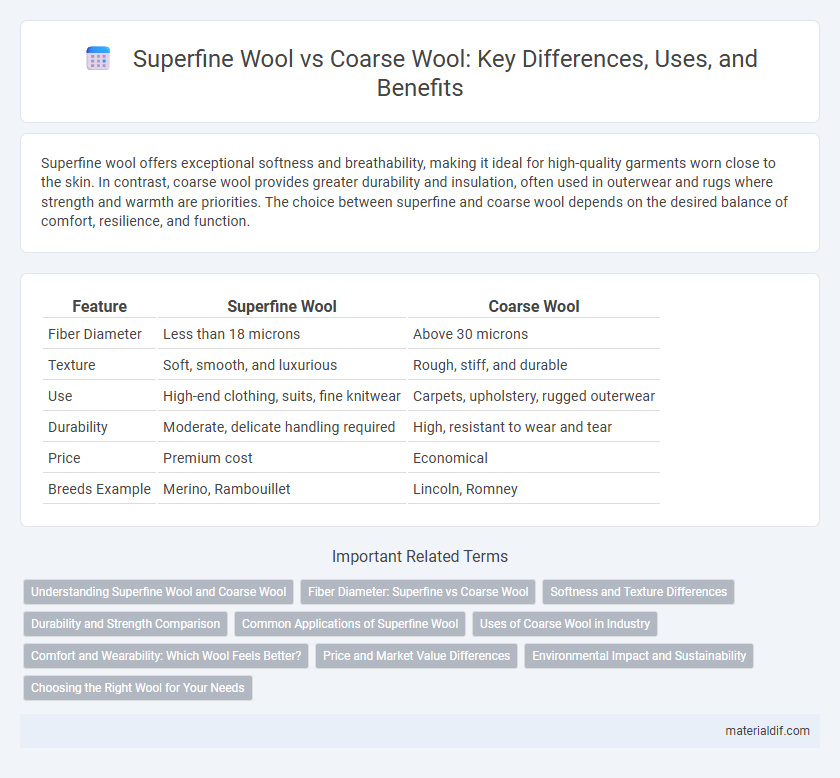Superfine wool offers exceptional softness and breathability, making it ideal for high-quality garments worn close to the skin. In contrast, coarse wool provides greater durability and insulation, often used in outerwear and rugs where strength and warmth are priorities. The choice between superfine and coarse wool depends on the desired balance of comfort, resilience, and function.
Table of Comparison
| Feature | Superfine Wool | Coarse Wool |
|---|---|---|
| Fiber Diameter | Less than 18 microns | Above 30 microns |
| Texture | Soft, smooth, and luxurious | Rough, stiff, and durable |
| Use | High-end clothing, suits, fine knitwear | Carpets, upholstery, rugged outerwear |
| Durability | Moderate, delicate handling required | High, resistant to wear and tear |
| Price | Premium cost | Economical |
| Breeds Example | Merino, Rambouillet | Lincoln, Romney |
Understanding Superfine Wool and Coarse Wool
Superfine wool, with fiber diameters typically under 18.5 microns, offers exceptional softness, breathability, and insulation, making it ideal for luxury garments and close-to-skin wear. Coarse wool, characterized by thicker fibers above 30 microns, provides greater durability and water resistance, commonly used in heavy textiles like carpets and outerwear. Understanding the fiber diameter directly impacts the application, comfort, and performance of wool products in various industries.
Fiber Diameter: Superfine vs Coarse Wool
Superfine wool features a fiber diameter typically less than 18.5 microns, resulting in exceptional softness and comfort ideal for high-end garments. Coarse wool, with fiber diameters exceeding 30 microns, offers greater durability and insulation but lacks the smooth texture of superfine wool. The variation in fiber diameter directly influences fabric softness, breathability, and suitability for different clothing applications.
Softness and Texture Differences
Superfine wool, such as Merino, features extremely fine fibers measuring below 19 microns, resulting in exceptional softness and a smooth, lightweight texture ideal for next-to-skin garments. Coarse wool, often sourced from breeds like Romney or Lincoln, contains thicker fibers above 30 microns, producing a rougher texture suited for durable outerwear and upholstery. The fiber diameter directly influences softness, with finer fibers providing superior comfort and less itchiness compared to the more rigid and abrasive feel of coarse wool.
Durability and Strength Comparison
Superfine wool, characterized by its ultrafine fibers typically below 18.5 microns, offers exceptional softness but has lower durability and tensile strength compared to coarse wool. Coarse wool, with fiber diameters above 30 microns, provides superior strength and resilience, making it more suitable for heavy-duty textiles and outerwear. The denser, thicker fibers in coarse wool enhance abrasion resistance and longevity, whereas superfine wool prioritizes comfort and fineness over durability.
Common Applications of Superfine Wool
Superfine wool, characterized by its ultra-fine fibers measuring less than 18.5 microns in diameter, is predominantly used in high-end fashion, luxury suits, and fine knitwear due to its exceptional softness and breathability. It is favored for premium scarves, next-to-skin garments, and performance wear that demand both comfort and durability. Unlike coarse wool, which is often utilized in heavy outerwear, carpets, and upholstery, superfine wool excels in applications where a lightweight, smooth texture and thermal regulation are essential.
Uses of Coarse Wool in Industry
Coarse wool, characterized by thicker fibers measuring over 30 microns, is widely used in industrial applications such as carpet manufacturing, insulation materials, and upholstery due to its durability and resilience. Its robust nature makes it ideal for products requiring strong, hard-wearing textiles that withstand heavy use and abrasion. Industries also utilize coarse wool in mattress stuffing and soundproofing panels, leveraging its natural breathability and moisture-wicking properties.
Comfort and Wearability: Which Wool Feels Better?
Superfine wool, with its fibers measuring less than 19 microns in diameter, offers superior softness and breathability, making it exceptionally comfortable against the skin compared to coarse wool, which typically exceeds 30 microns and can feel rough or itchy. The moisture-wicking and temperature-regulating properties of superfine wool enhance wearability for extended periods, especially in active or layering scenarios. Coarse wool, while more durable and insulating, is better suited for outerwear or rugs where direct skin contact is minimal, highlighting the distinct comfort advantages of superfine wool in apparel.
Price and Market Value Differences
Superfine wool commands a higher price and market value due to its finer fiber diameter, softness, and suitability for luxury garments, often selling at premium rates per kilogram compared to coarse wool. Coarse wool, with thicker, tougher fibers, is less desirable in high-end fashion markets but remains valuable in industrial applications and lower-cost textiles, thus generally fetching a significantly lower price. Market trends indicate rising demand for superfine wool among luxury apparel producers, driving its price premium and reinforcing its superior economic position relative to coarse wool.
Environmental Impact and Sustainability
Superfine wool generally has a lower environmental impact compared to coarse wool due to its higher quality fibers requiring less processing and waste during manufacturing. The production of superfine wool supports sustainable farming practices by promoting selective breeding and improved animal welfare, which reduces the overall carbon footprint. In contrast, coarse wool often demands more intensive processing and energy consumption, leading to increased environmental strain.
Choosing the Right Wool for Your Needs
Superfine wool, known for its exceptional softness and fine fiber diameter often below 18 microns, is ideal for high-end garments requiring comfort and luxury. Coarse wool, with thicker fibers exceeding 30 microns, excels in durability and insulation, making it suitable for rugged outerwear and heavy-duty textiles. Selecting the right wool depends on balancing softness against strength, considering factors like wearability, climate, and intended garment use.
Superfine Wool vs Coarse Wool Infographic

 materialdif.com
materialdif.com